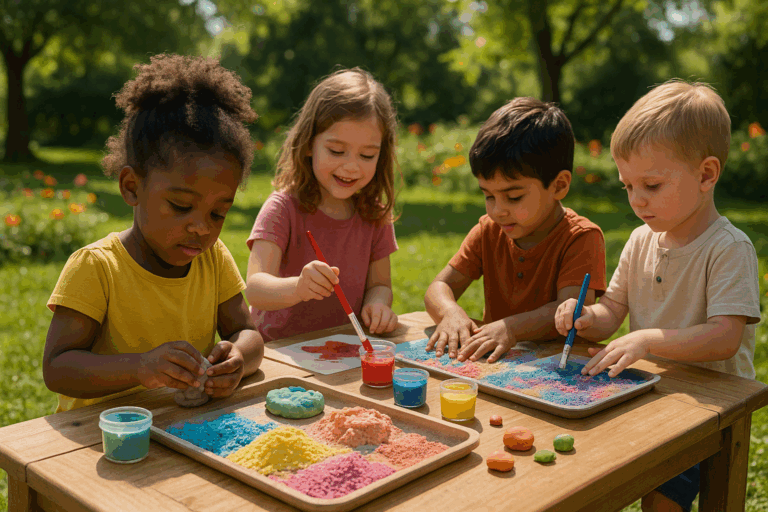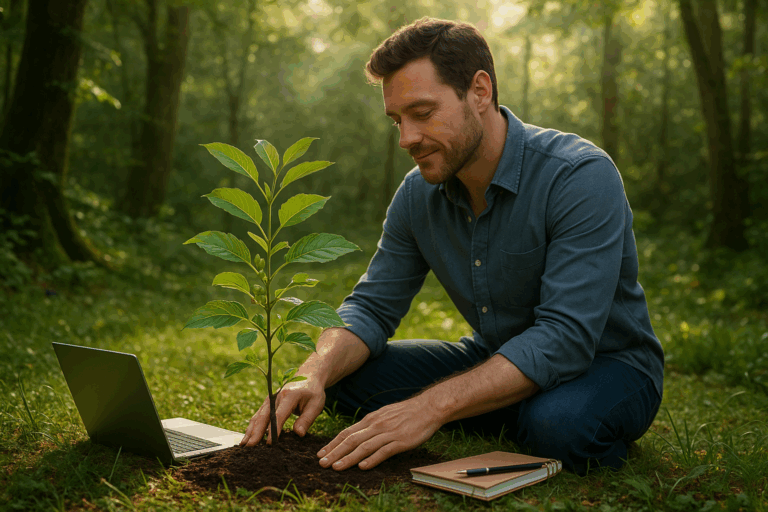From the color of the nursery to the style of the crib, every decision seems monumental. However, nothing quite compares to the importance of health-related decisions, especially when it comes to our little ones’ teething phase. 🧸
When your baby’s first tooth starts to peek through those soft gums, it’s both an exciting and challenging time. Those little pearly whites may be cute, but they can also cause quite a bit of discomfort. Enter the teething toy – a parent’s best friend during this stage. But with the increasing awareness of the environmental impact of plastic, the quest for plastic-free teething solutions has become a significant point of focus. 🌎
It’s no secret that plastic has been the go-to material for a vast majority of teething toys over the years. Its durability, easy cleaning, and molding capabilities make it seemingly perfect for the job. However, recent studies and increasing environmental consciousness have highlighted the need to say goodbye to plastic. Not just for the sake of our planet, but also for the health and safety of our children. 👶🏻
Why Go Plastic-Free?
The answer to this question is two-fold. First, plastic is notorious for its long degradation period, which can span hundreds of years, causing devastating effects on our environment. Second, some plastics contain harmful chemicals like BPA, phthalates, and PVC that could potentially leach into your baby’s system. Hence, the clamor for safer, more eco-friendly alternatives. 🌿
The Alternatives
Fortunately, the market has responded to this growing demand with an array of plastic-free teething solutions. From organic fabrics to natural rubber and wooden options, there’s a plastic-free teething solution to fit every preference and budget. This article will delve deep into each of these alternatives, helping you make an informed decision for your little teether. 🦷
What to Expect in this Ultimate Guide
In this comprehensive guide, we will explore the world of plastic-free teething solutions, breaking down the pros and cons of each option, and helping you navigate the sea of alternatives. We will demystify terms like ‘BPA-free’, ‘phthalate-free’, and ‘PVC-free’, and explain why these terms are so important when choosing a teething solution. 💡
Furthermore, we will explore the health and safety aspects of each alternative, providing a thorough analysis of materials, shapes, sizes, and textures. We will also provide practical tips on cleaning and maintaining your chosen teething solution, to ensure it remains safe and effective. 👍🏻
Rest assured, this guide will arm you with all the necessary information to say goodbye to plastic and embrace a healthier, more sustainable choice for your baby’s teething needs. So let’s embark on this journey together towards a plastic-free teething experience. 🍼
Remember, every decision you make as a parent matters, especially those that affect your little one’s health and our environment. Here’s to making informed choices and raising the next generation of eco-conscious individuals! 🌍
🌍 Embracing a Plastic-Free Lifestyle: The Starting Point
Imagine a world where our little ones can grow, explore, and learn in an environment free from the harmful effects of plastic. It’s a vision that is not only possible but becoming increasingly achievable as more parents and caregivers turn to plastic-free alternatives, especially during the crucial teething phase. In this ultimate guide, we’ll delve deep into the world of plastic-free teething solutions. Buckle up; it’s time to say goodbye to plastic!
Our journey towards a plastic-free lifestyle begins with understanding the problem at hand. Plastic, while incredibly versatile and convenient, has dire consequences for our health and the environment. When it comes to baby products, especially teething toys, the risks associated with plastic are even more pronounced. As babies gnaw on these toys, they may be exposed to harmful chemicals like BPA and phthalates.
But fear not, the solution is in sight! There are numerous plastic-free teething alternatives available in the market today. From natural rubber to organic cotton, these options not only provide relief for your teething tot but also contribute towards a healthier planet. Intrigued? Let’s dive deeper.
🔎 Natural Rubber: The Wonder Material for Teething Toys
One of the most popular plastic-free alternatives for teething toys is natural rubber. Extracted from the sap of the Hevea tree, natural rubber is non-toxic, biodegradable, and incredibly durable. But what sets it apart is its elasticity and soft texture, providing just the right amount of resistance for a teething baby’s gums.
Brands like Hevea and Sophie the Giraffe have revolutionized the teething toy industry with their natural rubber products. They offer a wide range of shapes and designs, from cute animal shapes to ergonomic teethers, providing endless entertainment and comfort for your little one. Wondering how natural rubber stacks up against plastic? Check out the comparison table below.
Material
Durability
Safety
Environmental Impact
Plastic
High
Potential exposure to harmful chemicals
Negative
Natural Rubber
High
Non-toxic
Positive
If you’re curious to see how these natural rubber teethers are made, check out the video “Making of Sophie the Giraffe” on the Sophie the Giraffe Official YouTube channel.
🌿 Organic Cotton: The Soft and Safe Choice
Another brilliant plastic-free alternative for teething toys is organic cotton. Organic cotton is grown without the use of harmful pesticides, making it safe for your baby’s mouth and hands. It is also incredibly soft, providing a soothing surface for your little one to chew on.
Many companies have embraced organic cotton for their teething products. Brands like Under the Nile and Finn + Emma offer a range of organic cotton teethers in adorable designs. But perhaps the best thing about these toys is their dual functionality. Not only do they serve as teethers, but they also double as comforting soft toys, offering your little one a familiar companion during their teething phase.
As with natural rubber, the advantages of organic cotton over plastic are quite significant. Check out the comparison below for a clearer picture.
Material
Comfort
Safety
Environmental Impact
Plastic
Average
Potential exposure to harmful chemicals
Negative
Organic Cotton
High
Non-toxic and gentle on skin
Positive
For a visual experience, take a look at the video titled “How Organic Cotton is Made” on the Fairtrade Foundation YouTube channel. It provides a fascinating insight into the production process of organic cotton.
🍁 Wooden Teethers: Back to Basics
Going back to our roots, wooden teethers are another great plastic-free option. Wood is a naturally durable and safe material, free from any harmful chemicals. It also offers a unique texture that can be quite comforting for a baby’s sore gums.
Many types of wood are used in the production of wooden teethers, including maple, beech, and ash. Brands such as Holztiger and Plan Toys are well-known for their wooden teething toys. Each piece is meticulously crafted, ensuring not only safety and comfort but also aesthetic appeal.
So, how does wood compare to plastic when it comes to teething toys? Here’s the lowdown:
Material
Durability
Safety
Environmental Impact
Plastic
High
Potential exposure to harmful chemicals
Negative
Wood
High
Non-toxic
Positive
If you’re interested in seeing how wooden toys are crafted, watch the video “The Making of Wooden Toys” on the PlanToys Official YouTube channel.
ConclusionIn conclusion, we have navigated the vast ocean of software engineering, shedding light on several key areas. From understanding the fundamentals of programming languages such as Java and Python to the elaborate layers of network systems, our journey was both comprehensive and enlightening. We delved into the principles of Agile methodologies and scrutinized the importance of testing in software development. And most importantly, we realized that technology isn’t just about writing code, but about creating value and solving problems.
Firstly, we explored the cornerstone of software development – programming languages. We learned that they are the tools with which we build software solutions, and without them, our ideas would remain just that – ideas. Languages such as Java and Python are not just syntax and semantics, but are bridges that translate human thought into a format that machines understand. They are essential in shaping the landscape of our technological future.
Next, we unraveled the complexity of network systems. We discovered that they are like the highways that connect different parts of a software system, enabling communication and collaboration. Without a well-designed network system, a software application would be an isolated island, unable to interact with its environment.
We also touched upon Agile methodologies, acknowledging that software development is a dynamic process that requires flexibility and adaptability. Agile methods facilitate this by promoting continuous improvement, collaboration and responsiveness to change.
Lastly, we emphasized the significance of testing in ensuring the quality and reliability of software products. We understood that testing isn’t a luxury, but a necessity. It’s the safety net that catches bugs before they wreak havoc, and the microscope that reveals opportunities for improvement.
In the grand scheme of things, all these components come together to form a system that creates value, solves problems and ultimately, makes life easier. That’s the beauty of software engineering – it’s not just about the code, but about the impact it makes on society.
I encourage you to keep exploring, learning and growing. Remember that every line of code you write, every problem you solve and every value you create, contribute to a better world. The world of software engineering is vast and ever-changing, and there’s always more to learn.
If you found this article useful, feel free to share it with your friends and colleagues. You can also leave a comment below if you have any questions or insights. The more we share our knowledge and experiences, the more we can grow together as a community.
Here are some resources for further reading:
[Java Programming](https://www.oracle.com/java/technologies/javase-jdk11-downloads.html) 📘
[Python Programming](https://www.python.org/) 📗
[Agile Methodologies](https://www.agilealliance.org/agile101/) 📙
[Software Testing](https://www.guru99.com/software-testing-introduction-importance.html) 📕
Remember, knowledge shared is knowledge multiplied. Happy coding! 😉
Source References:
[Oracle – Java](https://www.oracle.com/java/technologies/javase-jdk11-downloads.html)
[Python Official Website](https://www.python.org/)
[Agile Alliance](https://www.agilealliance.org/agile101/)
[Guru99 – Software Testing](https://www.guru99.com/software-testing-introduction-importance.html)
Keep in mind, the journey of learning never ends. So, let’s continue to learn, share, and create a better technological future. Keep coding! 💻🚀🌐



